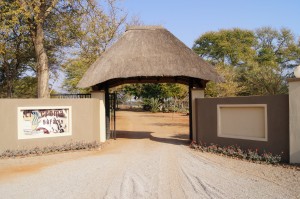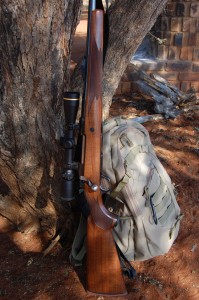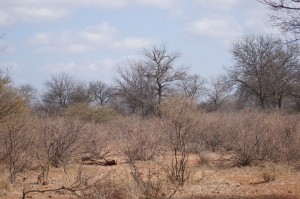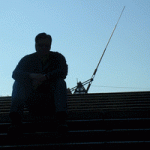Safari Adventures of a Neophyte Hunter – Part I
As Clif was quick to remind me, almost daily, unfortunately…it is called Hunting. Not shopping.
==================================================================
To start…some basic details, as I’m sure even the general framework of an African Hunting Safari is foreign to many, as it was to me. Our Safari involved 9 days of hunting in the Limpopo province of South Africa. Our outfitter was Limcroma, who provided the accommodations, meals, drinks, and most importantly, our Professional Hunters (PH). Limcroma is a well known and highly respected outfitter, winning the North Texas SCI 2012 Outfitter of the Year award.
In terms of firepower, Clif had a .375, Stacy brought a .30-06, and I borrowed a Remington 7mm Magnum from a friend. It is a great gun, but as I found out from all of the PH’s, it is just not quite enough gun for African Plains Game. They prefer a bit more firepower…the .30-06 or .308 were strongly recommended to me for any return trip, as well as any .375.
We were the only hunters at our location, which turned out to be a very good thing. (We could recount our adventures, trials, and tribulations as “newbies”, and not be be lost in the crowd of experienced hunters, as might happen at a larger camp.) It was on a farm owned by the Venter family (Willem, Elana, and son Adriaan), and they, along with our PH’s, served as our hosts during the trip.
A typical day involved getting up around 6:30-7:00, having a light breakfast, and heading into the bush around 7:30-8:00. We would hunt until around noon, then return home for lunch and rest. About 2:30, we were back in the bush until dark, which was around 6:00. Dinner was always a top-notch affair, as wonderful Elana provided some of the most amazing meals I’ve ever had: Kudu, Impala, Eland, Gemsbok, Steenbuck, and Wildebeest, Beef, and Pork all made the menu at some point. (I am still dreaming of Impala Lasagna and Eland Steaks.)
The hunt itself was a fascinating experience, and I can see how people come to love it. My PH (typically there is one PH for 2 hunters, but with three of us, I had the solo PH), tracker, and I would go to a “game farm”, which was actually 1000’s of acres of bush, with occasional sandy roads laid out in grid format. We would start in the truck looking for animals and/or herds, and this could last for several minutes if we were lucky, or we could spend a whole morning or afternoon driving around looking for a particular species. Don’t think that this somehow turned the effort into simple target practice, however. The use of the truck was a practical expediency to get in the ballpark of where the prey was, but almost without fail it involved extensive stalking through the bush.
We typically had 1-2 species in mind each day (one of which was always a Warthog in my case), and would track accordingly. The PH’s know the land and the animals, including eating habits, sleeping habits, sense of smell, eyesight, hearing, whether they travel in herds or solo (and that can change, depending on the season), their footprints, what their crap looks like, etc. Any combination of those characteristics could come into play as we were searching for, tracking, and stalking a particular animal.
Nights were spent sitting around the campfire, with beer, wine, and liquor flowing freely. There was no TV, and phone connectivity was very limited. To get even a light signal, we had to stand on a stump next to the barbeque pit. We called that spot “The Altar”. At first the lack of Internet connectivity was frustrating, but overall it was a blessing, as it really forced us to remove ourselves from the rest of the world, and just enjoy that particular time and place.
Conversations alternated between Afrikaans and English. All of our hosts and PH’s were great people with good senses of humor, and they clearly enjoyed each other’s company. There was much re-telling of stories about past hunts and adventures, although it was hard to follow, as they would default to Afrikaans. While we never quite mastered the language, which sounds like a combination of Dutch and German, we were able to quickly recognize one word that seems to transcend all languages (warning – bad language alert)…”fook”.
The hunting memories are naturally the most vivid and intense, but the time sitting around the table or campfire, engaging in general bullshit-guy-talk, was also an integral part of the experience. On the last evening, as I prepared to leave South Africa sans Warthog, Willem came over to me and, looking down at my plate full of spare rib bones, dryly commented, “I see you finally killed your pig”.
========================================================================================
Days 1-3 – Fail fast; fail often
Day 1
My first opportunity came late in the morning of our first full day. My PH Innes spotted a small herd of Impala, and we tracked through some brush and down a dirt road until we were 70-80 yards from them. They were just off the road in some light brush. Innes was a perfect first-PH for me…he moved in a very deliberate fashion while stalking, and his calm demeanor would, eventually, pay dividends for me. My tracker/skinner was Kleinboy, who was also excellent at his craft and an invaluable assistant throughout. Innes slowly and quietly put down the sticks (a tripod used to rest the rifle on to get a good, stable shot). For the first time in my life, I lifted a gun and looked through a scope to see an animal at the other end. I wondered what that moment would be like, but the exhilaration allowed no time for self-reflection. The herd was 4 females and one male. The females were in the front, and the male was in the rear. As I looked through the scope, it was like Sesame Street was teaching me to count to 5 by watching Impalas cross the screen. The first female stepped out of the brush into a clearing and looked straight at us. (“One Impala!” says the Count.) “Not that one…female” whispered Innes. She continued on, and was followed by the second female, which followed the same routine. (“Two Impala!”) “Female”, Innes quietly repeated.
Then, a non-sequitur, like a clueless assistant wandering onto a Hollywood movie set in the middle of an intense scene: A cow lumbered slowly into the road and directly into my cross hairs. She was very large, and walked straight at me (still 60-70 yards away), completely unaware that she was interrupting a pivotal moment in this unfolding drama. I chuckled, and fortunately she eventually faded off into the brush as well.
Two more females came and went, until finally Innes whispered “the next one is the male…wait until he is in the clearing. When he stands and looks at you, line up and take your shot.” I could feel my heart rate accelerate and blood pressure skyrocket. “Holy shit” I was thinking …”I’m actually going to shoot!”
One thing I had never thought about prior to this trip was what it actually takes to kill a pretty damn big animal with a relatively small metal projectile. I suppose I’ve always thought that getting shot just about anywhere on your body would be a bad thing, so the specific location of the shot is not necessarily critical. (Experienced hunters are reading this and laughing, no doubt.) As it turns out, there is a relatively small area – no more than a square foot on larger animals, and less on smaller ones – that is the target zone. For the animals we were hunting, that target was straight up the front legs, and roughly midway up the torso. A shot at that spot would go through the front shoulder bone, and continue through the heart or lungs, or possibly both if you were fortunate. Depending on the animal, the bullet might continue through the opposite shoulder bone as well. The broken bones prevent the animal from travelling more than a few dozen yards, and the punctured heart or lungs lead to a quick death. A shot into other organs or other parts of the body (excepting the brain, of course) may ultimately be fatal, but will likely not lead to immediate death, which is of course what every good hunter desires.
The male did not follow the path of the females, however, and went behind a bush in the clearing. When he did finally stop, his front half was behind some light brush. Dammit. I patiently waited for him to back up so that I could get a clear shot, but it did not happen. He continued on quietly, and the moment passed. Innes and Kleinboy were unfazed, and we while we continued to track them for a while, the opportunity was lost.
A while later, we were standing in another clearing, and Innes looked way down the road (these guys must have 20-10 eyesight), and quietly told me to get my gun…the Impala was standing in the middle of the road eating. 5 minutes later, after quietly working our way through the brush to get closer (well, they were pretty quiet…I am not known for my stealth walking capabilities), we peeked out from the brush, about 80 yards from the Impala. He was no longer broadside, but instead directly facing us. The situation did not allow for a standing shot, so Innes set the sticks for a shot from my knees. It was a tough, uncomfortable position, but I told him I was willing to try it. My muscles were tired, and I was not able to stabilize my body very well. A more experienced hunter would have tried it, but also would have known if the situation was not right for them. Having just missed a chance earlier, however, I was determined to not let another opportunity escape on this first day. And, while in retrospect I know it was a bad decision, at the time I was anxious to take my first shot.
It was not a good shot, and it went wide left. The impala darted back into the brush, safe for another day.
========================================================================================
Day 2
Day 2 was on a different farm, named, aptly as it would turn out for me over the course of the safari, “Bitterpan”.
The primary target was Blue Wildebeest. We began working our way along the roads, and after no more than 15 minutes, Kleinboy suddenly stopped the truck. 130 yards in front of us, just standing there, posing perfectly for our purposes, was a large Bull Blue Wildebeest. Innes calmly and quietly told me to line him up and take my shot.
Shooting off a pad on the back of a truck is similar to shooting off of sticks. It allows the shooter to rest the gun comfortably and line up a good, stable shot. Or so they say. As the Bull got into my site, either he was dancing wildly, or I was not holding the gun still. As Innes and Kleinboy never commented about “that amazing dancing Wildebeest”, I am guessing it was the latter. In a horrible repeat of the prior day’s impala shot, I did indeed pull the trigger, and the shot went left. Unfortunately, and much worse, this shot did not miss. It hit the Wildebeest in the right hind leg. He jumped and immediately disappeared into the bush. A few minutes later, now with his gun in hand, Innes quietly followed his tracks and the occasional trickle of blood. 100 yards into the bush, we heard movement on the other side of some dense brush and trees. Innes quickly moved through, only to see the Wildebeest disappear before he could get off a shot.
The rest of the day was spent tracking the Wildebeest. Hitting and injuring an animal is the worst possible outcome for everyone involved. Obviously it is painful for the animal, and he will eventually die from the injury. For the hunter, it is some combination of embarrassment and humiliation. For the PH and tracker, it means, at least in this case, a very long day. It was fascinating to watch them work – seeing the smallest droplets of blood, following hoof prints, scanning the horizon for movements or signs of wildebeest in the area. It was something that I wish had not happened, but it also allowed me to see them ply their craft in a way that I otherwise would not have.
There wasn’t a lot of conversation on this particular day, as neither Innes nor I are terribly chatty by disposition, and certainly not on this day. At some point late in the morning, however, possibly in an attempt to find some level of solace in my situation, I asked how him common misses and “woundings” were. My assumption was that the people who would commit the time and money to an African Safari would largely be experienced hunters, and that poor shooting would be a rare exception.
His response, though, surprised me. “Not uncommon” he said.
“How often do you find the animals that are wounded?” I asked, hopefully.
He did his best to put a positive spin on his response. “It does happen.”
“Very often?”
“No. Not often.”
Unfortunately, we never did find him. Innes estimated that he would die sometime within two weeks. At that point they would see vultures, and could go and recover the skull and horns. They will be sent to me, and I will keep them as a reminder of the perils of poor shooting.
========================================================================================
Day 3
Innes smartly decided that I would benefit from sitting in a Blind and getting a bit closer shot next time. It was at a watering hole, and we saw an abundance of wildlife come and go. Kudu, Waterbuck, Warthogs (not males, unfortunately), female Impala, and, yes… male Impala.
After having partaken of the “stalk” and been blessed with 2-3 legitimate opportunities to take an Impala and Wildebeest over the prior 2 days, part of me felt a little guilty about resorting to the Blind for my first kill. It was valuable, however, in allowing me to finally cross that threshold, and to do it confidently. When the moment came, it was a perfect shot, and after being hit, the Impala ran no more than 30-40 yards. He collapsed, and was dead a few seconds later.
After Innes congratulated me on a fine shot, I put my hand on his body and felt the warmth, then grabbed his horns so that I was looking into his eyes. I had been curious what I might feel at that moment, having finally shot and killed an animal for the first time. I think I wanted to feel some deep connection to the animal, or some great empathy for having just taken his life. Or, that seemed like the kind of thing I should want to feel. The truth is, though, after 2 days of misses and near misses, I was simply glad to have taken a shot that was more than just a starter’s pistol.
Innes was also happy. If the Blind had not worked out, I fear he might have shown up at my doorstep the next day with an impala on a leash and a target painted on his side.
The impala did not suddenly make me a great hunter, however, as there was another miss later in the day, this time with a Gemsbok from 100 yards. The stress skyrocketed…the act of shooting, especially in light of the Wildebeest fiasco, felt like the roll of dice, and I was crapping out all over the place.
That night I could barely sleep. I spent hours replaying each missed shot in my mind. I recalled all of my practice at the range, and how confident I had gotten in that setting. I moved my right index figure slowly, over and over, practicing the motion of pulling the trigger. 6 more days of hunting seemed like a life sentence. I didn’t want to sit in a blind for the rest of my trip, but I also couldn’t see how Innes could trust me to not be in a blind.
The next morning I grabbed the sticks and my rifle, and was out on the range. I didn’t actually shoot, but went through the motions repeatedly to diagnose the problem. My stance and hand placement needed some minor adjustments (thanks Clif and Innes!), but I also just needed to look through my scope and remember what success looked and felt like. On the range I had been pretty damn accurate, so I just needed to calm down, slow down, and be patient. I just hoped I’d have an opportunity to apply that learning outside of a blind.
Coming Soon…Part II












Dave….really enjoying these postings, will pass these along to fellow hunters, they will enjoy as well. Cannot wait for the next installment!
Dave – I’m really enjoying this read! It take me to Africa! Kind of like the “Capstick” books do. I look forward to your next writing!
Thanks Mr. Hobson! Great to hear from you, and glad you are enjoying it. I’ll confess that I’m enjoying re-reading it myself, and reliving the experiences.
Your recounting of your experiences is fantastic. I can’t wait for the next installment! I’m wondering…did they smear the blood of your first kill on your face, or made you sing “hakuna matahtah” while dancing and holding the fresh, still beating heart high above your head? Video, please…
It may sound odd, but I did dip my hand in the blood a couple of times. There was some Steenbuck and Kudu blood on my hat, but I suspect it has washed off by now.
No Hakuna Matata, though.
Wow…that is one amazing story. I, like you, really haven’t shot guns much, so I can only imagine what you were feeling. Keep the stories coming!